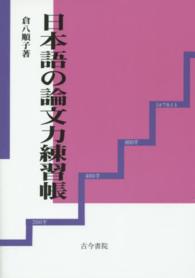- ホーム
- > 洋書
- > 英文書
- > Science / Mathematics
Full Description
There has long been a strong collaboration between geologists and archaeologists, and the sub-field of geoarchaeology is well developed as a discipline in its own right. This book now bridges the gap between those fields and the geophysical technique of ground-penetrating radar (GPR), which allows for three-dimensional analysis of the ground to visualize both geological and archaeological materials. This method has the ability to produce images of the ground that display complex packages of materials, and allows researchers to integrate sedimentary units, soils and associated archaeological features in ways not possible using standard excavation techniques. The ability of GPR to visualize all these buried units can help archaeologists place ancient people within the landscapes and environments of their time, and understand their burial and preservation phenomena in three-dimensions.
Readership: Advanced students in archaeology and geoarchaeology, as well as practicing archaeologists with an interest in GPS techniques.
Contents
About the Author vii
Acknowledgments viii
1 Introduction to Ground]penetrating Radar in Geoarchaeology Studies 1
Introduction 1
Scales and Applications of Geoarchaeological Studies with GPR 3
Basics of the GPR Method 4
Integrating GPR with the Geological and Archaeological Record 6
References 10
2 Basic Method and Theory of Ground]penetrating Radar 12
Introduction 12
Production of Reflections, Depth of Penetration, and Resolution 14
Data Collection and Recording 15
Production and Processing of Reflection Profiles 16
More Advanced Data Processing Steps 18
Interpretation of GPR Reflections in Profiles 19
Resolution of Stratigraphic Units 22
Weather and Moisture Differences as They Affect Resolution 27
References 32
3 Integration of Geology, Archaeology, and Ground]penetrating Radar 34
Introduction 34
Examples of Correlating Radar Reflections to Define Stratigraphic Interfaces 35
References 44
4 Fluvial, Alluvial Fan, and Floodplain Environments 46
Introduction 46
Fluvial Systems 47
Fluvial Terraces 51
Alluvial Fans 56
References 60
5 Soils Horizons, Peat Bogs, and Swamps 62
Introduction 62
Soil Horizons 63
Swamps and Peat Bogs 69
References 71
6 Beaches, Sand Dunes, and other Coastal Environments 73
Introduction 73
Beaches 74
Erosion Features along Coasts 77
Lagoon and Tidal Flats 79
Aeolian Dunes 81
References 90
7 Lakes and Deltas 92
Introduction 92
Lakes 93
Deltas 94
References 97
8 Caves and Rock Shelters 99
Introduction 99
Rock Shelters 100
Mapping Adjacent to Rock Shelters 104
Caves 106
References 111
9 Anthropogenic Features and Urban Environments 113
Introduction 113
Middens 114
Anthropogenic Deposits 118
Urban Settings 122
References 130
10 Conclusions 132
Collection of Data for this Book and the Future of GPR in Geoarchaeology 132
Environments Where GPR is Most Applicable in Geoarchaeology 134
The Future of GPR in Geoarchaeology 136
References 136
Glossary of Common GPR Terms 138
Index 143







